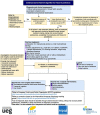Guideline for the diagnosis and treatment of Faecal Incontinence-A UEG/ESCP/ESNM/ESPCG collaboration
- PMID: 35303758
- PMCID: PMC9004250
- DOI: 10.1002/ueg2.12213
Guideline for the diagnosis and treatment of Faecal Incontinence-A UEG/ESCP/ESNM/ESPCG collaboration
Erratum in
-
Corrigendum.United European Gastroenterol J. 2022 Jul;10(6):606-607. doi: 10.1002/ueg2.12258. Epub 2022 May 31. United European Gastroenterol J. 2022. PMID: 35639836 Free PMC article. No abstract available.
Abstract
Introduction: The goal of this project was to create an up-to-date joint European clinical practice guideline for the diagnosis and treatment of faecal incontinence (FI), using the best available evidence. These guidelines are intended to help guide all medical professionals treating adult patients with FI (e.g., general practitioners, surgeons, gastroenterologists, other healthcare workers) and any patients who are interested in information regarding the diagnosis and management of FI.
Methods: These guidelines have been created in cooperation with members from the United European Gastroenterology (UEG), European Society of Coloproctology (ESCP), European Society of Neurogastroenterology and Motility (ESNM) and the European Society for Primary Care Gastroenterology (ESPCG). These members made up the guideline development group (GDG). Additionally, a patient advisory board (PAB) was created to reflect and comment on the draft guidelines from a patient perspective. Relevant review questions were established by the GDG along with a set of outcomes most important for decision making. A systematic literature search was performed using these review questions and outcomes as a framework. For each predefined review question, the study or studies with the highest level of study design were included. If evidence of a higher-level study design was available, no lower level of evidence was sought or included. Data from the studies were extracted by two reviewers for each predefined important outcome within each review question. Where possible, forest plots were created. After summarising the results for each review question, a systematic quality assessment using the GRADE (Grading of Recommendations, Assessment, Development and Evaluations) approach was performed. For each review question, we assessed the quality of evidence for every predetermined important outcome. After evidence review and quality assessment were completed, recommendations could be formulated. The wording used for each recommendation was dependent on the level of quality of evidence. Lower levels of evidence resulted in weaker recommendations and higher levels of evidence resulted in stronger recommendations. Recommendations were discussed within the GDG to reach consensus.
Results: These guidelines contain 45 recommendations on the classification, diagnosis and management of FI in adult patients.
Conclusion: These multidisciplinary European guidelines provide an up-to-date comprehensive evidence-based framework with recommendations on the diagnosis and management of adult patients who suffer from FI.
Keywords: GRADE; Sacral neuromodulation; clinical guidelines; diagnosis; faecal incontinence; fecal incontinence; guidelines; ptns; treatment; unwanted loss of feces.
© 2022 The Authors. United European Gastroenterology Journal published by Wiley Periodicals LLC on behalf of United European Gastroenterology.
Conflict of interest statement
The authors would like to report the following potential conflict(s) of interest:
D. Keszthelyi, ZonMw (Dutch government), Foundation for Gastroenterology (MLDS), Allergan, Grunenthal GmbH, Will Pharma SA research supports, Bayer GmbH, Biocodex Benelux consulatation fees; J. Kleijnen, European Society of Coloproctology consultation fees; E. Bradshaw, Medtronic honoraria; E.V. Carrington, MMS/Sandhill scientific research suppor, Laborie consultations fees and speaking at event; G. Chiarioni, Takeda, Alpha sigma consulation fees, Kyowa‐Kirin speaking at event, member of the Anorectal Committee of the Rome Foundation and of the International Consultation on Continence; Y. Maeda, Medtronic research support, Creo medical consultation fee and Atellas speaking at event; D. Pohl, Vifor, Alfa Sigma research supports, Sanofi, Allergan, Medtronic consultation fee, Sanofi speaking at event; M. Rydningen, Medtronic consultation fees; C.J. Vaizey, Renew medical stock shareholder and United Kingdom continence society research support; S.O. Breukink, Medtronic research support; M. Gladman, Medtronic consultation fees.
Figures
Comment in
-
Coexistent faecal incontinence and constipation: Common but frequently overlooked.United European Gastroenterol J. 2022 Jul;10(6):601-602. doi: 10.1002/ueg2.12263. Epub 2022 Jun 1. United European Gastroenterol J. 2022. PMID: 35652134 Free PMC article. No abstract available.
-
Health aspects of faecal incontinence are complex and multi-layered.United European Gastroenterol J. 2022 Jul;10(6):603-604. doi: 10.1002/ueg2.12261. Epub 2022 Jun 4. United European Gastroenterol J. 2022. PMID: 35666023 Free PMC article. No abstract available.
References
-
- Carrington E, Scott S, Bharucha A, Bharucha A, Mion F, Remes‐Troche JM, et al. International Anorectal Physiology Working Group and the International Working Group for Disorders of Gastrointestinal Motility and Function . Expert consensus document: Advances in the evaluation of anorectal function. Nat Rev Gastroenterol Hepatol. 2018;15:309–23. - PMC - PubMed
-
- National Institute for Health and Clinical Excellence . Faecal incontinence: the management of faecal incontinence in adults NICE; 2007.
Publication types
MeSH terms
LinkOut - more resources
Full Text Sources


